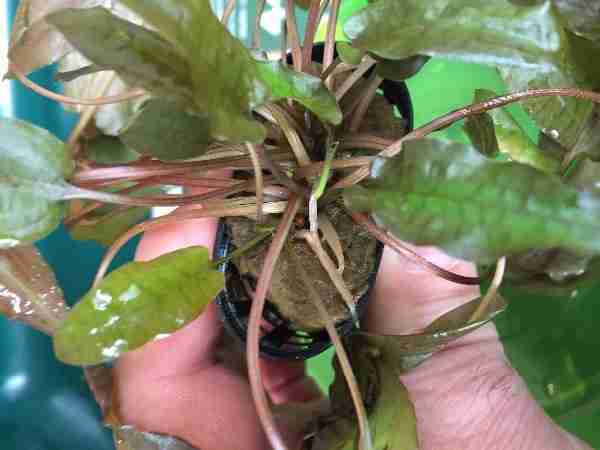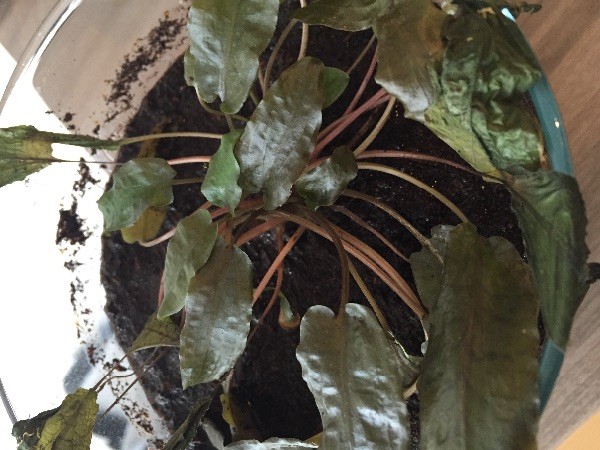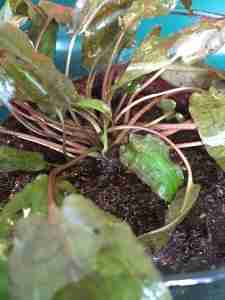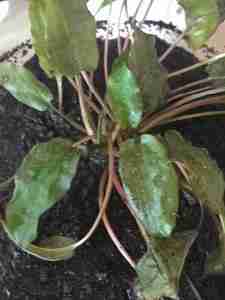Cryptocorynes can be acclimated to emersed growth with some work and patience. These aroids are prone to melting back to the rhizome but they will grow back readily if left unaltered. We see cryptocornes usually submerged at the local fish store and others hobbyists usually offer the plants in trade that were grown submerged. The truth is commercially they are grown emersed, dry, above water. They grow faster and propagate faster, and you can do this easily in the comfort and privacy of your own home. Commercial nurseries grow plants above the water, no algae, better shipping, faster growth, more lush growth often, and all around a great way to make more plants for yourself or to trade.

This plant was just taken from a submersed tank. It was bought as Cryptocoryne Lutea from a local fish stores tank. I brought it home and put in a jar with some potting mix to convert it over to emersed growth in order to add it to a wabi kusa, insularium, or as I call it a ‘Biotop’. With a little attention you can easily do this also.

If your plant is in a net pot with some sort of media take it out and tease the media from the roots gently. Try not to break the roots as best you can. A toothpick or bamboo skewer can work to tease the rockwool or coconut tape off if you don’t have tweezers.
After the roots are mostly cleaned the plant is placed into a good potting mix. Try to avoid potting mixes that have organic fertilizers like chicken manure or steer manure as the salts in the manure may cause a problem. A soilless potting mix will be the best substrate for the blackwater streams. Adding a 1:1:1 ratio of pelletized dolomite, coarse sand or fine gravel, and potting mix for clearwater streams. Some of the fringe cryptocorynes that are hard to keep can best be kept with sand and dolomite. The vast majority of readily available cryptocorynes, especially at local fish stores, will grow very nicely in potting soil. Fill the vessel with the plant slowly to wet the substrate, you want it wet but not a layer of water above the dirt. Filling it too rapidly will make the soilless media float and make a mess. Go slow and let it soak in. Then keep the water level just at the top of the soil.

After the cryptocoryne has been planted in the potting mix being careful not to bury the rhizome too deeply make sure to keep the humidity high. If you are using a jar put the lid on and tighten it for a day or two. If an open top container is used put a lid on loosely or lay clear plastic over the top after spritzing water over the foliage. If the plants start to look like they are compacting and getting crispy spray them. If they are simply dry then theres no real need to spray them too much. Wilting, withering, and getting crispy are good reasons to spray them more often. In the photo above you can see that the foliage is too dry and needs to be sprayed more often.

After several days begin to periodically open the lid or move the plastic sheeting so that more room air begins to mix over the plant. You will likely lose a few leaves or the plant may completely melt back and die. If the plant melts back use tweezers or your fingers and pull away the slimey looking plants and stems but leave the rhizome as it is undisturbed. It should grow back and have good emersed leaves.

More and more leaves are coming up from the center of the rhizome. These leaves are going to be much more readily adaptable to the humidity of emersed growth. They won’t miraculously grow in very low humidity but most containers with water in them to wet the soil will support them nicely unless you live in quite arid regions. A major key it to be patient. Many times a plant will look like it has died back. Cryptocorynes especially will reboot from their rhizomes and regrow. It is a defense mechanism for wet and dry periods of the year.
Once the leaves are nice and dry they will be much more tough and have more of a terrestrial leaf look and feel to them. They are ready to add into your wabi kusa, insularium, or “biotop” or as standalone plants in the form of kokedama or shitakusa. Emersed grown they also grow faster. Emersed grown plants also withstand shipping a whole lot better than aquatic grown plants. With a good fertilizer regiment they can grow fas, have more plantlets produced, and have a lot more color. Be sure to check out the articles on Agrarium fertilizers that were posted from Biotope One. I had been experimenting with plant growth regulators to make more plants form adventitious shoots but that is for another article.
 Biotope One A Study of Flora and Fauna
Biotope One A Study of Flora and Fauna 


